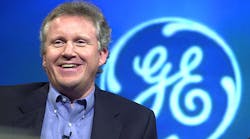Technology Leader Of The Year -- Connecting Profits And Preservation
Sales growth has always been an important measure of a corporate leader's progress. During Jeffrey R. Immelt's tenure at GE, sales grew from $125.913 billion, when he succeeded the legendary John "Jack" F. Welch Jr. in 2001, to $152.363 billion in 2004. (Analysts expect $170 billion for 2005.) But past performance has to be tempered by how a leader is enabling future growth and purpose. At GE, Immelt's future progress will hinge on his leadership in the deployment of an environmental strategy labeled Ecomagination.
For the business world, Ecomagination can be considered an example of how closely customer needs relate to environmental issues. (Some analysts have noted a similarity to Toyota's hybrid strategy where environmental issues become primary in the customer's mind.)
Ecomagination replaces yesterday's attitudes that merely relegate environmentalism to regulations that hinder and constrain business and trade. In Immelt's words: "For far too long, many people in the private sector have viewed protecting the environment as a no-win for business. We believe that the growing market for environmental technologies can get us where we need to be."
Ecomagination views environmental objectives as opportunities to meet customer needs better while improving revenue growth.
View Past Technology Leaders
View The 2005 Winners
Immelt knows he is bucking business world tradition in seeking "green" in being "green." He recalled his own acclimation when he announced the strategy at Washington, D.C.,'s George Washington University on May 9th: "When I became chairman and CEO of GE in 2001, I would never have imagined that I would be standing here today giving a speech focusing on the environment."
He went on to explain how well he understood and appreciated the rationale of Ecomagination:
"In 2005, GE is making a new commitment to our customers around the world to define the cutting edge in cleaner power and environmental technology. We have taken a long look around, and this is what we see: diminishing domestic oil and natural gas reserves; our continued dependence on foreign sources of energy; increasingly scarce resources like water in an ever more populated world; and signs of global climate change."
Immelt's conclusion: "Those are the convergence of forces that demands a revolution in technology so that our country can stay competitive." GE's Ecomagination action plan is reminiscent of the words of founder Thomas Edison in the early days of the 127-year-old company: "I never perfected an invention that I did not think about in terms of the service it might give others. . . I find out what the world needs, then I proceed to invent."
Cutting Deeply Into Consumption
Will Ecomagination catalyze a new competitive mode for industry? GE's environmental direction was noticed even before Ecomagination was announced. Last fall GE was included for the first time in the Dow Jones Sustainability Index -- the 300 best firms on environmental, social and financial criteria.
At the very least Ecomagination is accelerating the internal operating goals and focus on the business of environmentalism. A doubled R&D investment is one example. Immelt says by 2010 GE will be investing $1.5 billion, up from $750 million in 2004.
GE has initially identified 17 products that meet its Ecomagination criteria. Immelt expects to add five each year. He says these products must significantly and measurably improve customers' environmental and operating performance. In 2004 revenue from that product category totaled about $10 billion. By 2010 Immelt says GE hopes to double revenue from products and services that provide significant and measurable environmental performance -- to $20 billion, with more aggressive goals thereafter. Immelt sees a reshaping of GE that will make it "more innovative, more global and closer to the customer."
Preparations for that future have revitalized GE's R&D commitment. Under Immelt, GE has vastly expanded global research and development presence. In 2002, GE opened a facility in Shanghai, China, and initiated a $100 million renovation of the global R&D center in Niskayuna, N.Y. That was followed by the 2004 opening of the Munich, Germany, research operations.
Immelt sees R&D as an important driver of Ecomagination especially in connection with GE's transportation and energy businesses. To some observers Toyota's hybrid energy strategy came to mind when Immelt named Mark Little as the new director of global research (the ninth in the company's R&D history). To begin with, Little comes from GE Energy's power generation business, where he had served as vice president since 1997. At the very least, GE's energy technology has Prius-like competitive attractiveness, both in terms of efficiency and reduced emissions.
Consider the potential of GE's coal gasification technology. GE estimates that if all conventional coal plants in the United States could be re-engineered to use the company's IGCC technology, carbon dioxide emissions could be cut by nearly 320 million tons. (That is equal to nearly a fourth of the greenhouse gas-reduction goal proposed for the United States under the Kyoto Protocol.)
Additional validation for Ecomagination' energy focus is rapidly rising fuel consumption patterns. Immelt notes that since 1990, oil consumption has doubled with an almost three-fold increase for natural gas. In that period the global population has increased by roughly a billion people, GE says.
Energy efficiency also plays mightily into GE's lighting business. The company estimates that if every U.S. household replaced one 100-watt incandescent light bulb with a GE compact fluorescent bulb equivalent in light output, the energy savings could power more than a million U.S. homes for over a year.
Energy savings quickly mount for commercial buildings. GE estimates that a hotel that switched from 300 100-watt incandescents to the GE compact fluorescent bulbs could save more than $11,000 over the bulbs' lives, even factoring in the higher initial cost.
GE's LM2500+ marine gas turbine is another Ecomagination example. GE says a ship powered by such turbines emits nearly 67% less nitrogen oxide than the average passenger vessel.
For an even more dramatic example, consider GE's Evolution Series locomotives. GE says the locomotive defines Ecomagination -- and redefines efficiency. The locomotive generates 16 cylinders' worth of horsepower with only 12 cylinders, cuts key emissions up to 40% (as compared with the company's prior models) and is the first locomotive to meet the new U.S. Environmental Protection Agency emissions standards -- all while delivering as much as 10% lower lifecycle costs to customers. And the fuel cost savings to customers is impressive: Compared with GE locomotives built last year, a single Evolution Series locomotive will consume 189,000 fewer gallons in its lifetime -- or enough, GE says, to power another Evolution locomotive for seven months. (In May when Immelt announced Ecomagination, he noted that the order backlog for the Evolution locomotive was at 1,500 units. Immelt added that the Evolution locomotive would be followed by a hybrid locomotive product that will cut energy usage another 20%.)
GE Transportation's aircraft engines also express the Ecomagination energy message. Its latest offering, the GEnx engine demonstrates dramatic gains in fuel efficiency and performance with lower emission than other engines in its class, GE says. Consider: If all of today's fleet of twin-aisle aircraft had GEnx engines, annual carbon dioxide emissions would be reduced by an amount equal to what 1.2 million acres of forest can absorb in a year, GE says. The engine was selected for the Boeing 787 and the Airbus A350.
GE Energy's photovoltaic technology also carries a strong Ecomagination energy theme. Playing off a virtually inexhaustible energy source, the sun-powered systems involve no noise or pollution. GE estimates that if just 7% of the land area of Arizona were covered with its PV-165 solar modules, enough power would be generated to power the entire United States.
Appliance customers also are beginning to enjoy the benefits of Ecomagination-inspired efficiencies. The large capacity GE Profile Harmony washers, for example, target both energy and water efficiency.
Ecomagination also has a positive marketing resonance with plastic technology at GE Advanced Materials. In one example, researchers have demonstrated how pigment infused plastics are able to greatly reduce paint usage in automotive applications. Characteristics of the GE-developed polymer include super-high gloss, attractive metallic colors and resistance to scratches, chemicals and weathering.
GE estimates that if every sport utility vehicle registered in the U.S. had been built with its LEXAN SLX body panels, nearly 55,000 tons of paint-related volatile organic compounds emissions would have been avoided.
|
The Change Advantage |
GE's own products don't comprise all of the attention for an Ecomagination marketing and technology strategy. Immelt's thinking extends to how GE's new Infrastructure business unit can add value while supporting industrial technology needs of developing economies such as China. One indicator of the business opportunities in China: "Of the 20 most polluted cities of the world, 16 are in China. The Chinese government has set aside $85 billion for environmental spending. This will require substantial commitment in new power generating technology and desalination."
In addition to helping customers meet their environmental goals, Immelt has also set substantial internal operating goals for pollution and emission reduction. GE is now committed to reducing its greenhouse gas emissions by 1% by 2012. Compare that 1% with the 40% increase that would occur without the action plan, Immelt says. The company also is reducing the intensity of its greenhouse gas emissions 30% by 2008 (both instances are compared with 2004).




